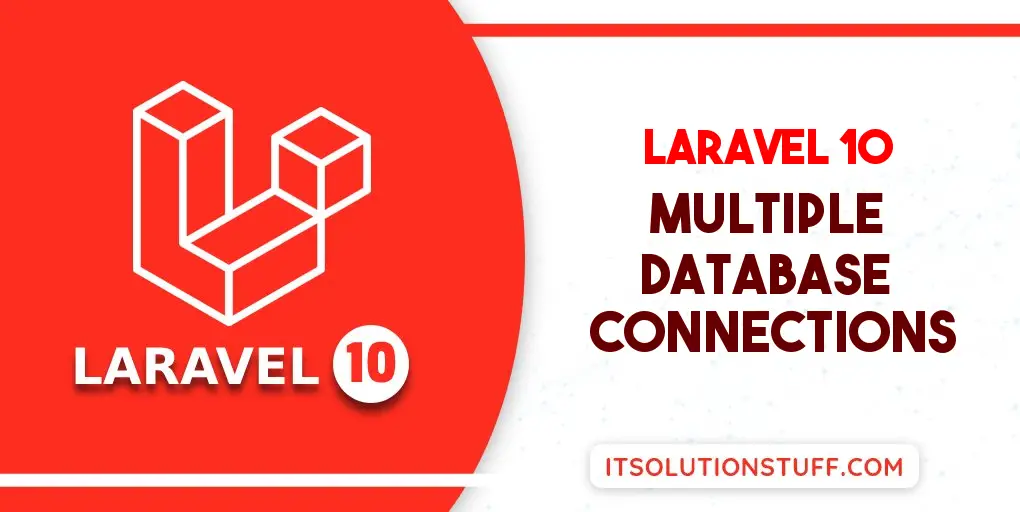Laravel 10 Multiple Database Connections Example
Hey Guys,
This simple article demonstrates of laravel 10 multiple database connections. I would like to show you how to use multiple database connections in laravel 10. you can see multiple database connection in laravel 10. I would like to share with you laravel 10 multiple database connections .env.
I will give you step by step implementation of how to use laravel 10 multiple DB connections using the .env file. we will add a configuration variable on the .env file and use it in the database configuration file. You can just follow me, I will also learn how to work with migration, model and database queries for multiple database connections.

As we know sometimes we need to use multiple database connections like MySQL, MongoDB, etc. I can say when you work with a large number of projects then you will need maybe. So let's follow bellow steps.
Set ENV Variable:
Here, you need to set configuration variable on .env file. let's create as bellow:
.env
DB_CONNECTION=mysql
DB_HOST=127.0.0.1
DB_PORT=3306
DB_DATABASE=mydatabase
DB_USERNAME=root
DB_PASSWORD=root
DB_CONNECTION_SECOND=mysql
DB_HOST_SECOND=127.0.0.1
DB_PORT_SECOND=3306
DB_DATABASE_SECOND=mydatabase2
DB_USERNAME_SECOND=root
DB_PASSWORD_SECOND=root
Database Configuration:
Now, as we created variable in env file, we need to use that variable on config file so let's open database.php file and add new connections key as like bellow:
config/database.php
<?php
use Illuminate\Support\Str;
return [
'default' => env('DB_CONNECTION', 'mysql'),
'connections' => [
.....
'mysql' => [
'driver' => 'mysql',
'url' => env('DATABASE_URL'),
'host' => env('DB_HOST', '127.0.0.1'),
'port' => env('DB_PORT', '3306'),
'database' => env('DB_DATABASE', 'forge'),
'username' => env('DB_USERNAME', 'forge'),
'password' => env('DB_PASSWORD', ''),
'unix_socket' => env('DB_SOCKET', ''),
'charset' => 'utf8mb4',
'collation' => 'utf8mb4_unicode_ci',
'prefix' => '',
'prefix_indexes' => true,
'strict' => true,
'engine' => null,
'options' => extension_loaded('pdo_mysql') ? array_filter([
PDO::MYSQL_ATTR_SSL_CA => env('MYSQL_ATTR_SSL_CA'),
]) : [],
],
'mysql_second' => [
'driver' => 'mysql',
'url' => env('DATABASE_URL_SECOND'),
'host' => env('DB_HOST_SECOND', '127.0.0.1'),
'port' => env('DB_PORT_SECOND', '3306'),
'database' => env('DB_DATABASE_SECOND', 'forge'),
'username' => env('DB_USERNAME_SECOND', 'forge'),
'password' => env('DB_PASSWORD_SECOND', ''),
'unix_socket' => env('DB_SOCKET_SECOND', ''),
'charset' => 'utf8mb4',
'collation' => 'utf8mb4_unicode_ci',
'prefix' => '',
'prefix_indexes' => true,
'strict' => true,
'engine' => null,
'options' => extension_loaded('pdo_mysql') ? array_filter([
PDO::MYSQL_ATTR_SSL_CA => env('MYSQL_ATTR_SSL_CA'),
]) : [],
],
.....
Getting Data from Multiple Database using DB:
I will give write two routes with getting products from different database connections. you can see simple example with DB.
let's add two routes in your file:
routes/web.php
<?php
use Illuminate\Support\Facades\Route;
/*
|--------------------------------------------------------------------------
| Web Routes
|--------------------------------------------------------------------------
|
| Here is where you can register web routes for your application. These
| routes are loaded by the RouteServiceProvider within a group which
| contains the "web" middleware group. Now create something great!
|
*/
/*------------------------------------------
--------------------------------------------
Getting Records of Mysql Database Connections
--------------------------------------------
--------------------------------------------*/
Route::get('/get-mysql-products', function () {
$products = DB::table("products")->get();
dd($products);
});
/*------------------------------------------
--------------------------------------------
Getting Records of Mysql Second Database Connections
--------------------------------------------
--------------------------------------------*/
Route::get('/get-mysql-second-products', function () {
$products = DB::connection('mysql_second')->table("products")->get();
dd($products);
});
Multiple Database Connections with Migration:
you can create separate migrations for multiple database connections:
Default:
<?php
.....
public function up(): void
{
Schema::create('blog', function (Blueprint $table) {
$table->increments('id');
$table->string('title');
$table->string('body')->nullable();
$table->timestamps();
});
}
.....
Second Database:
<?php
.....
public function up(): void
{
Schema::connection('mysql_second')->create('blog', function (Blueprint $table) {
$table->increments('id');
$table->string('title');
$table->string('body')->nullable();
$table->timestamps();
});
}
.....
Multiple Database Connections with Model:
Default:
<?php
namespace App\Models;
use Illuminate\Database\Eloquent\Factories\HasFactory;
use Illuminate\Database\Eloquent\Model;
class Product extends Model
{
use HasFactory;
protected $fillable = [
'name', 'detail'
];
}
Second Database:
<?php
namespace App\Models;
use Illuminate\Database\Eloquent\Factories\HasFactory;
use Illuminate\Database\Eloquent\Model;
class Product extends Model
{
use HasFactory;
protected $connection = 'mysql_second';
protected $fillable = [
'name', 'detail'
];
}
Multiple Database Connections in Controller:
Default:
<?php
use App\Models\Product;
class ProductController extends BaseController
{
/**
* Write code on Method
*
* @return response()
*/
public function getRecord()
{
$products = Product::get();
return $products;
}
}
Second Database:
<?php
use App\Models\Product;
class ProductController extends BaseController
{
/**
* Write code on Method
*
* @return response()
*/
public function getRecord()
{
$product = new Product;
$product->setConnection('mysql_second');
$something = $product->find(1);
return $something;
}
}
I hope it can help you...

